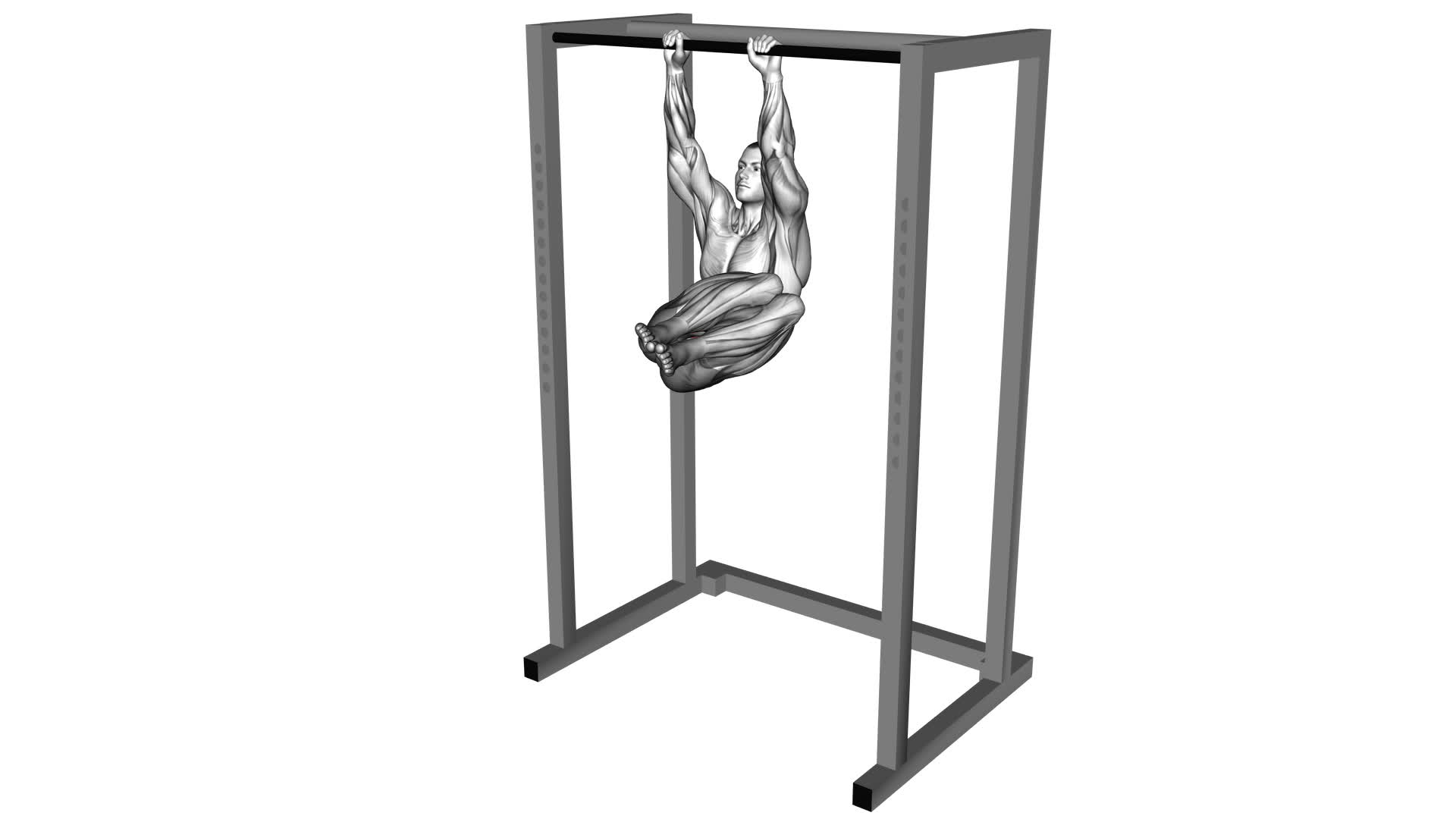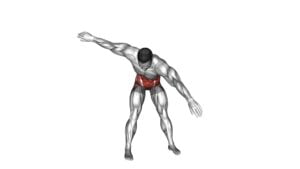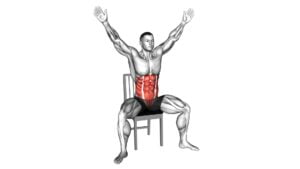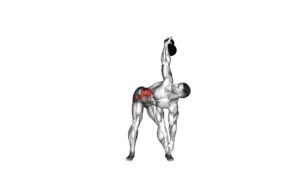Hanging Half Windmill – Video Exercise Guide & Tips

Looking to amp up your workout routine? Check out our Hanging Half Windmill exercise guide and tips.
Watch This Exercise Video
In this video, we'll walk you through the benefits of this challenging move, the equipment you'll need, proper form and technique, modifications for beginners, and advanced variations for experienced athletes.
Plus, we'll share some insider tips to help you maximize your results.
Get ready to take your fitness to new heights with the Hanging Half Windmill!
Key Takeaways
- The Hanging Half Windmill targets obliques, shoulders, arms, and upper back, resulting in a slimmer waistline, improved core stability, and upper body strength and stability.
- Incorporating the Hanging Half Windmill into a routine 2-3 times per week is recommended, starting with lower repetitions and gradually increasing as strength and endurance improve.
- Proper form and technique are crucial, including engaging core muscles, maintaining a straight body position, and avoiding common mistakes like not using momentum or not keeping a straight line from head to feet.
- Beginners can modify the exercise by starting with a shorter range of motion, using assistance like resistance bands or suspension trainers, and focusing on stability and control. Advanced variations and added weight can be incorporated for experienced athletes to challenge core and upper body strength.
Benefits of the Hanging Half Windmill
You will frequently experience numerous benefits from practicing the Hanging Half Windmill exercise. This exercise primarily targets your obliques, which are the muscles on the sides of your abdomen. By engaging these muscles, you can strengthen and tone them, resulting in a slimmer waistline and improved core stability. Additionally, the Hanging Half Windmill also engages your shoulders, arms, and upper back, helping to develop upper body strength and stability.
One of the key benefits of this exercise is its ability to improve your overall posture. As you perform the Hanging Half Windmill, you're required to maintain a tall and upright position, which helps to align your spine and improve your posture over time. This can be particularly beneficial for individuals who spend a significant amount of time sitting or hunching over a desk.
In terms of workout strategies, it's recommended to incorporate the Hanging Half Windmill into your routine at least two to three times per week. Start with a lower number of repetitions and gradually increase as your strength and endurance improve. To maximize the benefits, focus on maintaining proper form throughout the exercise, engaging your obliques and keeping your core tight.
Equipment Needed for the Exercise
To perform the Hanging Half Windmill exercise, what equipment is required? Luckily, this exercise doesn't require any special equipment. All you need is a sturdy pull-up bar or a set of gymnastic rings that can support your body weight. These can be easily found at your local gym or purchased for home use.
Before attempting the Hanging Half Windmill, it's important to warm up properly. This will help prepare your muscles and joints for the exercise, reducing the risk of injury. Some recommended warm-up exercises include arm circles, shoulder rolls, and wrist stretches. These exercises will help improve your range of motion and flexibility in the upper body, which is crucial for performing the Hanging Half Windmill correctly.
Now let's discuss some common mistakes to avoid during the exercise. One common mistake isn't engaging your core muscles. It's important to keep your core tight throughout the movement to maintain stability and control. Another mistake is swinging or using momentum to lift your legs. This can take away from the effectiveness of the exercise and increase the risk of strain or injury. Focus on using controlled movements and maintaining proper form throughout the exercise.
Proper Form and Technique
To perform the Hanging Half Windmill exercise with proper form and technique, there are a few essential tips to keep in mind.
First, ensure that your grip on the bar is secure and your shoulders are relaxed.
Second, engage your core and maintain a straight body position throughout the movement.
Lastly, watch the correct technique demonstration in the video to get a visual understanding of how the exercise should be performed.
Essential Form Tips
To ensure proper form and technique while performing the Hanging Half Windmill exercise, it's crucial that you focus on maintaining a stable core. This won't only help prevent common mistakes but also maximize muscle activation.
Here are some essential form tips to keep in mind:
- Keep your shoulders down and away from your ears to avoid unnecessary tension.
- Engage your glutes and hamstrings to create a stable base and support your lower body.
- Maintain a neutral spine throughout the movement to avoid excessive strain on your back.
Correct Technique Demonstration
Watch this video to see the correct technique for performing the Hanging Half Windmill exercise and learn how to maintain proper form and technique.
When performing this exercise, it's important to avoid common mistakes that can lead to common injuries. One common mistake is swinging too forcefully, which can strain the shoulders and wrists. To prevent this, focus on controlled movements and engage your core muscles to stabilize your body.
Another common mistake isn't maintaining a straight line from your head to your feet, which can put unnecessary stress on your spine. Remember to keep your body aligned throughout the movement.
Modifications for Beginners
If you're a beginner, you can modify the hanging half windmill exercise to suit your fitness level. Here are some beginner modifications and common mistakes to avoid:
- Start with a shorter range of motion: Instead of reaching all the way down to the ground, you can start by only going halfway or three-quarters of the way. This will help you build strength and flexibility gradually.
- Use assistance: If you find it challenging to hang from a bar, you can use a resistance band or a suspension trainer to support your weight. This will make the exercise more manageable while still allowing you to work on your core and upper body strength.
- Focus on stability: Instead of trying to rotate your legs as far as possible, concentrate on maintaining stability and control throughout the movement. This will help you develop a strong core and improve your balance.
Common mistakes to avoid when modifying the hanging half windmill exercise include:
- Using momentum: Swinging your legs or using momentum to complete the movement takes away the challenge and effectiveness of the exercise. Focus on controlled movements to get the most out of the exercise.
- Straining your neck: Avoid pulling on your neck or straining it during the exercise. Keep your neck relaxed and in a neutral position.
- Neglecting proper form: It's crucial to maintain proper form throughout the exercise. Keep your shoulders down and engage your core muscles to protect your lower back.
Advanced Variations for Experienced Athletes
For experienced athletes, there are several advanced variations of the hanging half windmill exercise that can further challenge your core and upper body strength. These advanced progressions are designed to push your limits and take your training to the next level.
One advanced variation is the hanging full windmill, where instead of stopping at a halfway point, you complete a full rotation with your legs. This requires even greater stability and control throughout the movement.
Another advanced progression is the hanging half windmill with added weight. By attaching a weight plate or dumbbell to your feet, you increase the resistance and intensity of the exercise. This helps to build even more strength in your core and upper body.
It's important to follow proper training protocols when attempting these advanced variations. Start with a lighter weight or smaller range of motion, and gradually increase the difficulty as you become more comfortable and confident. Always maintain proper form and technique to prevent injury.
Incorporating these advanced variations into your workout routine will challenge your muscles in new ways and help you continue to progress and improve.
Tips for Maximizing Your Workout Results
To maximize your workout results, it's important to implement effective workout strategies and utilize time-saving tips.
By focusing on exercises that target multiple muscle groups and incorporating high-intensity interval training, you can optimize your time at the gym and maximize your calorie burn.
Additionally, staying consistent with your workouts and maintaining proper form will help you achieve the best results and prevent injury.
Effective Workout Strategies
With the right pre-workout routine, you can achieve maximum results during your workout. Here are some effective workout strategies to help you maximize your workout results:
- Vary your workout intensity: Incorporate high-intensity intervals into your routine to challenge your body and burn more calories. Alternating between periods of intense exercise and active recovery can boost your metabolism and improve cardiovascular fitness.
- Increase your workout duration gradually: Instead of jumping into long, intense workouts right away, gradually increase the duration of your workouts over time. This allows your body to adapt and prevents overexertion or injury.
- Incorporate strength training: Adding strength training exercises to your routine can increase muscle mass, boost metabolism, and improve overall body composition. Aim for at least two days of strength training per week, targeting different muscle groups each session.
Time-Saving Workout Tips
Maximize your workout results with time-saving tips that will help you achieve your fitness goals efficiently.
Incorporating quick workout routines and efficient exercise techniques into your fitness routine can save you time while still delivering effective results.
One time-saving tip is to incorporate high-intensity interval training (HIIT) into your workouts. This involves alternating between short bursts of intense exercise and periods of rest or lower intensity. HIIT workouts are known for their ability to burn calories and increase cardiovascular fitness in a short amount of time.
Another time-saving tip is to combine exercises that work multiple muscle groups at once. For example, instead of doing separate exercises for your arms and legs, you can perform compound exercises like squats with bicep curls or lunges with shoulder presses.
Frequently Asked Questions
How Many Repetitions and Sets Should I Do for the Hanging Half Windmill Exercise?
You should determine the number of repetitions and sets for the hanging half windmill exercise based on your fitness goals and current level of strength.
It's generally recommended to start with 2-3 sets of 8-12 repetitions.
However, if you're a beginner, you may want to start with fewer repetitions and sets and gradually increase them over time.
Remember to listen to your body and adjust the intensity as needed.
Can I Do the Hanging Half Windmill Exercise if I Have a Shoulder Injury?
If you have a shoulder injury, it's important to consider shoulder rehabilitation exercises and modifications for shoulder injuries.
When it comes to the hanging half windmill exercise, it may not be suitable for you due to the strain it can put on your shoulders.
It's best to consult with a healthcare professional or a physical therapist who can provide you with tailored exercises that will aid in your recovery without worsening your shoulder injury.
Is It Necessary to Use a Weight or Resistance Band for the Hanging Half Windmill Exercise?
No, it isn't necessary to use a weight or resistance band for the hanging half windmill exercise. However, incorporating a weight or resistance band can increase the intensity of the exercise and provide additional benefits.
Without weights, the hanging half windmill exercise still offers benefits such as improving core strength, stability, and shoulder mobility.
Adding weights or resistance bands can further challenge your muscles and enhance the overall effectiveness of the exercise.
Should I Perform the Hanging Half Windmill Exercise Before or After My Cardio Workout?
Performing the hanging half windmill exercise before or after your cardio workout depends on your fitness goals. If you want to prioritize building strength and muscle, it's best to perform it before your cardio session. This way, you can focus on proper form and maximize the benefits of the exercise.
However, if your main goal is cardiovascular endurance, performing it after your cardio workout can be a great way to finish off your training session.
Can I Incorporate the Hanging Half Windmill Exercise Into a Full-Body Workout Routine?
You can definitely incorporate the hanging half windmill exercise into a full-body workout routine. It's a great exercise for working the core, shoulders, and upper body.
There are also variations of the hanging half windmill that you can try to target different muscles.
Adding this exercise to your routine will help you develop strength and stability in multiple areas of your body.
Conclusion
In conclusion, the hanging half windmill is a beneficial exercise that can be done with minimal equipment. By following proper form and technique, beginners can gradually build their strength and flexibility.
Advanced athletes can challenge themselves with variations of the exercise. By incorporating these tips into your workout routine, you can maximize your results and achieve your fitness goals.

Author
Years ago, the spark of my life’s passion ignited in my mind the moment I stepped into the local gym for the first time. The inaugural bead of perspiration, the initial endeavor, the very first surge of endorphins, and a sense of pride that washed over me post-workout marked the beginning of my deep-seated interest in strength sports, fitness, and sports nutrition. This very curiosity blossomed rapidly into a profound fascination, propelling me to earn a Master’s degree in Physical Education from the Academy of Physical Education in Krakow, followed by a Sports Manager diploma from the Jagiellonian University. My journey of growth led me to gain more specialized qualifications, such as being a certified personal trainer with a focus on sports dietetics, a lifeguard, and an instructor for wellness and corrective gymnastics. Theoretical knowledge paired seamlessly with practical experience, reinforcing my belief that the transformation of individuals under my guidance was also a reflection of my personal growth. This belief holds true even today. Each day, I strive to push the boundaries and explore new realms. These realms gently elevate me to greater heights. The unique combination of passion for my field and the continuous quest for growth fuels my drive to break new ground.







